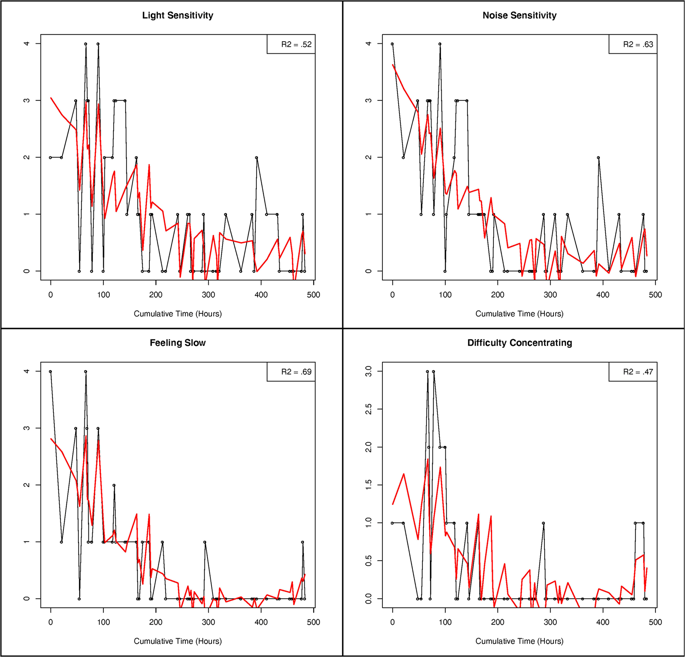Our official English website, www.x-mol.net, welcomes your
feedback! (Note: you will need to create a separate account there.)
Person-Specific Methods for Characterizing the Course and Temporal Dynamics of Concussion Symptomatology: A Pilot Study.
Scientific Reports ( IF 3.8 ) Pub Date : 2020-01-27 , DOI: 10.1038/s41598-019-57220-1 Amanda R Rabinowitz 1 , Aaron J Fisher 2
Scientific Reports ( IF 3.8 ) Pub Date : 2020-01-27 , DOI: 10.1038/s41598-019-57220-1 Amanda R Rabinowitz 1 , Aaron J Fisher 2
Affiliation

|
Better characterization of acute concussion symptomatology is needed in order to advance clinical and scientific understanding of persistent concussion symptoms. This paper aims to illustrate a novel framework for conceptualizing, collecting, and analyzing concussion symptom data. To that end, we describe the temporal and structural dynamics of acute concussion symptoms at the individual-patient level. Ten recently concussion adolescents and young adults completed 20 days of ecological momentary assessment (EMA) of post-concussion symptoms. Follow-up assessments were completed at 3 months post-injury. Network modeling revealed marked heterogeneity across participants. In the overall sample, temporal patterns explained the most variance in light sensitivity (48%) and the least variance in vomiting (5%). About half of the participants had symptom networks that were sparse after controlling for temporal variation. The other individualized symptom networks were densely interconnected clusters of symptoms. Networks were highly idiosyncratic in nature, yet emotional symptoms (nervousness, emotional, sadness), cognitive symptoms (mental fogginess, slowness), and symptoms of hyperacusis (sensitivity to light, sensitivity to noise) tended to cluster together across participants. Person-specific analytic techniques revealed a number of idiosyncratic features of post-concussion symptomatology. We propose applying this framework to future research to better understand individual differences in concussion recovery.
中文翻译:

针对特定人群的表征脑震荡症状的过程和时间动态的方法:一项初步研究。
为了促进对持续性脑震荡症状的临床和科学理解,需要更好地表征急性脑震荡症状。本文旨在说明一种用于概念化,收集和分析脑震荡症状数据的新颖框架。为此,我们在个人患者水平上描述了急性脑震荡症状的时间和结构动态。十名最近脑震荡的青少年和年轻人完成了脑震荡后症状的20天生态瞬时评估(EMA)。受伤后3个月完成随访评估。网络建模揭示了参与者之间明显的异质性。在整个样本中,时间模式解释了光敏度的最大差异(48%)和呕吐的最小差异(5%)。在控制了时间变化后,大约一半的参与者的症状网络稀疏。其他个体化症状网络是密集互连的症状簇。网络本质上是高度特质的,但是情绪症状(神经质,情绪,悲伤),认知症状(精神模糊,缓慢)和听觉过敏症状(对光的敏感度,对噪声的敏感度)倾向于聚集在参与者之间。特定于人的分析技术揭示了脑震荡后症状的许多特质。我们建议将此框架应用于未来的研究,以更好地了解脑震荡恢复中的个体差异。其他个体化症状网络是密集互连的症状簇。网络本质上是高度特质的,但是情绪症状(神经质,情绪,悲伤),认知症状(精神模糊,缓慢)和听觉过敏症状(对光的敏感度,对噪声的敏感度)倾向于聚集在参与者之间。特定于人的分析技术揭示了脑震荡后症状的许多特质。我们建议将此框架应用于未来的研究,以更好地了解脑震荡恢复中的个体差异。其他个体化症状网络是密集互连的症状簇。网络本质上是高度特质的,但是情绪症状(神经质,情绪,悲伤),认知症状(精神模糊,缓慢)和听觉过敏症状(对光的敏感度,对噪声的敏感度)倾向于聚集在参与者之间。特定于人的分析技术揭示了脑震荡后症状的许多特质。我们建议将此框架应用于未来的研究,以更好地了解脑震荡恢复中的个体差异。对噪音的敏感性)倾向于在参与者之间聚集在一起。特定于人的分析技术揭示了脑震荡后症状的许多特质。我们建议将此框架应用于未来的研究,以更好地了解脑震荡恢复中的个体差异。对噪音的敏感性)倾向于在参与者之间聚集在一起。特定于人的分析技术揭示了脑震荡后症状的许多特质。我们建议将此框架应用于未来的研究,以更好地了解脑震荡恢复中的个体差异。
更新日期:2020-01-27
中文翻译:

针对特定人群的表征脑震荡症状的过程和时间动态的方法:一项初步研究。
为了促进对持续性脑震荡症状的临床和科学理解,需要更好地表征急性脑震荡症状。本文旨在说明一种用于概念化,收集和分析脑震荡症状数据的新颖框架。为此,我们在个人患者水平上描述了急性脑震荡症状的时间和结构动态。十名最近脑震荡的青少年和年轻人完成了脑震荡后症状的20天生态瞬时评估(EMA)。受伤后3个月完成随访评估。网络建模揭示了参与者之间明显的异质性。在整个样本中,时间模式解释了光敏度的最大差异(48%)和呕吐的最小差异(5%)。在控制了时间变化后,大约一半的参与者的症状网络稀疏。其他个体化症状网络是密集互连的症状簇。网络本质上是高度特质的,但是情绪症状(神经质,情绪,悲伤),认知症状(精神模糊,缓慢)和听觉过敏症状(对光的敏感度,对噪声的敏感度)倾向于聚集在参与者之间。特定于人的分析技术揭示了脑震荡后症状的许多特质。我们建议将此框架应用于未来的研究,以更好地了解脑震荡恢复中的个体差异。其他个体化症状网络是密集互连的症状簇。网络本质上是高度特质的,但是情绪症状(神经质,情绪,悲伤),认知症状(精神模糊,缓慢)和听觉过敏症状(对光的敏感度,对噪声的敏感度)倾向于聚集在参与者之间。特定于人的分析技术揭示了脑震荡后症状的许多特质。我们建议将此框架应用于未来的研究,以更好地了解脑震荡恢复中的个体差异。其他个体化症状网络是密集互连的症状簇。网络本质上是高度特质的,但是情绪症状(神经质,情绪,悲伤),认知症状(精神模糊,缓慢)和听觉过敏症状(对光的敏感度,对噪声的敏感度)倾向于聚集在参与者之间。特定于人的分析技术揭示了脑震荡后症状的许多特质。我们建议将此框架应用于未来的研究,以更好地了解脑震荡恢复中的个体差异。对噪音的敏感性)倾向于在参与者之间聚集在一起。特定于人的分析技术揭示了脑震荡后症状的许多特质。我们建议将此框架应用于未来的研究,以更好地了解脑震荡恢复中的个体差异。对噪音的敏感性)倾向于在参与者之间聚集在一起。特定于人的分析技术揭示了脑震荡后症状的许多特质。我们建议将此框架应用于未来的研究,以更好地了解脑震荡恢复中的个体差异。











































 京公网安备 11010802027423号
京公网安备 11010802027423号